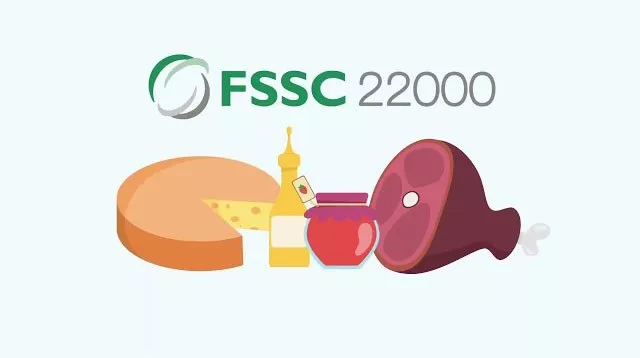What is the FSSC 22000 standard?
The Food Safety System Certification 22000 (FSSC 22000) is a globally recognised standard for Food Safety Management Systems (FSMS). An FSSC 22000 certification demonstrates that a robust and effective food safety management system is in place to meet the requirements of regulators, food business customers and consumers.
The FSSC 22000 Scheme is recognized by the Global Food Safety Initiative (GFSI) and supported by the European Food and Drink Association (CIAA) and the American Groceries Manufacturing Association (GMA).
This globally recognised food safety standard is for businesses of any size or complexity in the food supply chain. This includes manufacturers of food, beverages, ingredients, additives, pet and animal food, and packaging. FSSC 22000 also extends to storage, transportation, catering and retail operations.
FSSC 22000 also offers certification for integrated food safety management and quality management systems. This standard provides the framework for organisations to implement processes how they wish to meet the requirements.
FSSC 22000 has three components
Organisations can achieve FSSC 22000 certification in the following scopes:
- Food manufacturing (ISO/TS 22002-1)
- Catering (ISO/TS 22002-2)
- Food packaging manufacturing (ISO/TS 22002-4)
- Transport and storage (ISO/TS 22002-5)
- Food and feed for animals (ISO 22002-6)
- Retail and supermarkets (BSI/PAS 221)
TQCSI is licensed to provide accredited FSSC 22000 certification for the following PRPs:
- ISO/TS 22002-1:2009 – Food manufacturing and production of bio(chemicals)
- ISO/TS 22002-4:2013 – Food packaging manufacturing
Already ISO 22000 certified?
We can save you time and money if you are already certified to the ISO 22000 standard. We can help you transition to FSSC 22000 by reviewing the FSSC Additional Requirements and the relevant technical standards for your industry.
Find out how we can help make your transition to FSSC 22000 seamless. Get in touch today.
Learn more about the differences between HACCP, ISO 22000 and FSSC 22000.
Benefits of FSSC 22000 Certification
When you certify your FSMS to FSSC 22000, you meet internationally accepted standards for the safety of your food, feed and packaging. It demonstrates your commitment to food safety at all levels of your organisation. Furthermore, this international standard is recognised and accepted by the largest brands and retailers around the world, providing a significant competitive advantage.
The benefits of an FSSC 22000 certified food safety management system include:
Why certify with TQCSI?
We are the experts in international food safety standards. TQCSI is the leading global JASANZ accredited certification body in food safety management systems. We are routinely consulted by governments, industry and organisations to advise on food safety standards matters.
TQCSI has a global network of offices, each with a team of highly trained local auditors. Our auditors not only have industry and sector-specific knowledge but also an in-depth understanding of your local operating environment. So, you know that when you call on us to certify your FSMS, you will receive first-class service.


Start your Certification today
At TQCSI, we want to help you achieve your FSSC 22000 certification quickly and easily. To prevent delays in receiving your certification, get in touch today. There’s no need to wait until your Food Safety Management System is fully implemented.
Start Your CertificationPreparing for your FSSC 22000 Food Safety certification
When our auditors undertake the FSSC22000 Food Safety Management System certification process, they will assess your systems, supporting documentation and culture. By having all your documentation in order before we start, you can expect a fast, hassle-free FSSC 22000 certification process.
To help you get started, we have prepared a checklist of the system and documentation requirements that an FSSC 22000 Food Safety Management System should meet.
FSSC 22000 System Requirements
The FSSC 22000 requires organisations to show that they:
- Understand external and internal issues, and interested parties, relevant to food safety
- Have a Food Safety Policy declaring commitment to food safety
- Have appoint a Food Safety Team
- Develop and implement a Hazard Control Plan
- Develop a FSMS or Management Manual briefly addressing the clauses of ISO 22000 and specific FSSC 22000 requirements
- Implement food safety practices to address the respective pre-requisite program (PRP)
- Develop procedures, particularly for each of the critical control points (CCPs) and operational pre-requisite programs (OPRPs)
- Implement record keeping for monitoring of the CCPs and OPRPs
- Develop and monitor food safety objectives and targets
- Embrace food safety risks and opportunities
- Develop and implement a Food Defence Plan and Food Fraud Vulnerability Plan - Click here to learn about Food Defence & Food Fraud
- Monitor food safety performance
- Plan responses to food safety emergencies
- Ensure staff are competent and understand their food safety responsibilities
- Control food safety nonconformances and take corrective action for significant or repetitive nonconformances
- Ensure internal and external communication of food safety issues
- Implement evaluation and monitoring of external providers
- Implement an allergen management program
- Implement verification of the Hazard Control Plan and PRPs
- Conduct internal audits of the food safety management system
- Ensure senior management strategically review the food safety management system
Documentation Requirements for FSSC 22000 Certification
To satisfy the FSSC 22000 Food Safety requirements, consider the following documents:
- Food Safety Policy
- Hazard Control Plan
- FSMS or Management Manual
- Procedures
- Food Safety Improvement Plan (monitoring food safety objectives and targets)
- Food Defence Plan
- Food Fraud Mitigation Plan
- Emergency Plan
- Allergen Management Plan
- Records for OPRP and CCP monitoring
- Registers for nonconformances and corrective action
- Environmental Monitoring Plan
Implementing a FSSC 22000 Food Safety Management System
Your FSSC 22000 Food Safety Management System encompasses all the systems, processes, documentation and organisational culture that supports food safety and customer satisfaction. Our auditors will review the implementation of your Food Safety Management System against the FSSC 22000 requirements.
Certification Mark for FSSC 22000 Food Safety Management Systems
Once certified, you can display your commitment to Food Safety with our trusted certification mark. The TQCSI tick is internationally recognised as the highest Food Safety Management Systems certification level.
Want to know more about FSSC 22000 Certification?
FSSC 22000 certification provides a robust framework for managing food safety and quality throughout the supply chain, ensuring consistent and safe food products. It also enhances marketability and customer trust by demonstrating a commitment to internationally recognised standards and regulatory compliance.
Contact your local TQCSI office today to learn how FSSC 22000 certification can help your business, or email us at info@tqcsi.com


